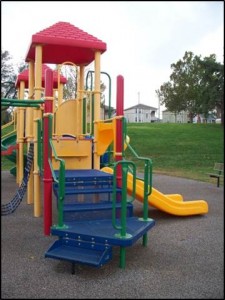|
Examining the distribution of park availability, features, and quality and relationships with child weight status across Greenville County, SC |
|
Project SummaryYouth obesity is a major public health concern due to the wide array of physical, social, and emotional health consequences that often accompany overweight and obese youth during childhood and even into adulthood. Alarmingly, the prevalence of childhood and adolescent obesity has increased over the past three decades with a disproportionate burden on youth that are low-income, racial/ethnic minorities, and reside in the southeastern United States. Policy, systems, and environmental (PSE) strategies are increasingly recognized as promising approaches for increasing active living and reducing obesity rates among youth. Within this paradigm, parks are key community assets for promoting physical activity and health, especially among youth. However, to support the development of a comprehensive strategy for addressing obesity and chronic diseases through parks, solid information is needed about the current state of resources in communities and the impact these open spaces are having on youth physical activity participation, obesity rates, and overall health. Environmental justice, broadly speaking, refers to the idea that no group should bear a disproportionate burden of the causes (e.g., lack of parks) or consequences (e.g., obesity) of environmental health issues. Numerous factors contribute to lower rates of physical activity among low income and minority residents, including lower education levels, less disposable income, and stress and fear associated with racism and poverty. However, another significant issue may be disparities in access to environmental resources that facilitate physical activity. This is an issue related to environmental justice and has been referred to as “deprivation amplification,” wherein persons with fewer personal resources that might support physical activity (e.g., income, knowledge) also tend to reside in areas that are more deprived of neighborhood physical activity resources (e.g., sidewalks, parks). Indeed, numerous studies have investigated this idea of ‘park deserts’ and have supported the idea that inequalities often exist by various sociodemographic indicators. Given the importance of parks to physical activity participation and to building healthy communities, a lack of access to quality park environments is a serious problem that has the potential to exacerbate rates of obesity and chronic disease among children, adults, and seniors from the most vulnerable backgrounds. Study Aims:
This project was a partnership between the University of South Carolina, six parks and recreation departments across Greenville County, LiveWell Greenville, and Furman University. |
|
| This study has been funded by the Piedmont Health Foundation, University of South Carolina Office of the Provost and the University of South Carolina Office of the Vice President for Research SPARC Graduate Research Grant Program. | |
Aim 1To examine whether the availability, features, and quality of parks are equitably distributed across the study area according to a variety of demographic indicators (income, race/ethnicity, education level, youth population, etc.)To examine whether the availability, features, and quality of parks are equitably distributed across the study area according to a variety of demographic indicators (income, race/ethnicity, education level, youth population, etc.) To accomplish Aim 1, we combined geographic mapping and observational audits of all public parks across Greenville County to examine whether park availability and quality was equitable across neighborhoods of different racial/ethnic and socioeconomic status. Information about a variety of demographic characteristics was downloaded for each census block group in Greenville County from the American Community Survey conducted by the U.S. Census Bureau. All publicly accessible parks were mapped using geographic information systems (GIS) technology to determine the number and total area of parks that intersect each census block group. We also conducted on-site audits of all parks in the city using the . Using data collected from the CPAT, we assessed the availability of park facilities and amenities and the level of park quality across diverse census block groups. All analyses took into account factors such as the size of the census block group, the total population, and the percentage of population less than 18 years of age. All of this information was displayed both statistically (e.g., percentages, correlations) and spatially (e.g., maps) to show the relationship between the demographic (income, race, etc.) composition of neighborhoods in Greenville and the availability and quality of parks. Findings from aim 1 of this project are described in this report and the following manuscript: Hughey, S.M., Walsemann, K.M., Child, S., Powers, A., Reed, J.A., & Kaczynski, A.T. (2016). Using an environmental justice approach to examine the relationships between park availability and quality indicators, neighborhood disadvantage, and racial/ethnic composition. Landscape and Urban Planning, 148, 159-169. https://doi.org/10.1016/j.landurbplan.2015.12.016 |
|
Aim 2To examine the relationship between park availability, features, and quality and obesity levels among youth in the study County Parks are critical components of healthy communities and can positively influence youth physical activity and potentially reduce obesity levels. Despite national-level efforts, childhood obesity rates remain high, with youth of low socioeconomic status (SES) and racial/ethnic minority backgrounds disproportionately affected. Some researchers have suggested that inequities in neighborhood built environment resources may contribute to disparities in youth obesity. However, relatively few studies have explored this hypothesis and assessed associations between specific park features, like playgrounds, and obesity. Even less research has been conducted to ascertain whether the relationship between park and playground availability and youth obesity is moderated by race/ethnicity or SES. Therefore, the purposes of aim 2 of this study were: 1) to examine associations between neighborhood park and playground availability and youth obesity, and 2) to assess whether these associations are moderated by youth race/ethnicity and SES. Findings from aim 2 of this project are described in the following manuscripts: Hughey, S.M., Kaczynski, A.T., Child, S., Moore, J.B., Porter, D., & Hibbert, J. (2017). Green and lean: Is neighborhood park and playground availability associated with youth obesity? Variations by gender, socioeconomic status, and race/ethnicity. Preventive Medicine, 95, S101-108. https://doi.org/10.1016/j.ypmed.2016.11.024 Stowe, E.W., Hughey, S.M., Hallum, S.H., & Kaczynski, A.T. (2019). Associations between walkability and youth obesity: Differences by urbanicity. Childhood Obesity, 15(8), 555-559. https://doi.org/10.1089/chi.2019.0063 McCarthy, S.M., Hughey, S.M., & Kaczynski, A.T. (2017). Examining sociodemographic differences in playground availability and quality and associations with childhood obesity. Childhood Obesity, 13(4), 1-8. https://doi.org/10.1089/chi.2016.0239 Hughey, S.M., Kaczynski, A.T., Child, S., Moore, J.B., Porter, D., & Hibbert, J. (2017). Green and lean: Is neighborhood park and playground availability associated with youth obesity? Variations by gender, socioeconomic status, and race/ethnicity. Preventive Medicine, 95, S101-108. Stowe, E.W., Hughey, S.M., Hallum, S.H., & Kaczynski, A.T. (2019). Associations between walkability and youth obesity: Differences by urbanicity. Childhood Obesity, 15(8), 555-559. McCarthy, S.M., Hughey, S.M., & Kaczynski, A.T. (2017). Examining sociodemographic differences in playground availability and quality and associations with childhood obesity. Childhood Obesity, 13(4), 1-8. |
|
Aim 3Explore global and local spatial clustering of youth obesity in the study County and determine which individual and neighborhood characteristics are related to spatial clustering of youth obesity Examining the determinants of childhood obesity is imperative to understand how to address and prevent the epidemic at a community level. Although epidemiological patterns of youth obesity across the U.S. have been established, fewer studies have examined spatial patterns of youth obesity at a local level. Among research that has explicitly employed spatial clustering methodology, very few studies have examined obesity patterns, particularly in youth. Investigating the geographic distribution of youth obesity at a local level is critical to 1) identify areas that have high rates and clustering of youth obesity, 2) explore whether the distribution of youth obesity is completely random or whether individual and area characteristics predict the observed patterns, and 3) determine whether geographic spatial clustering is contributing to observed disparities in youth obesity according to race/ethnicity and SES. Furthermore, the identification of geographic areas that have clustering of youth obesity may be particularly useful for pinpointing priority areas for public health intervention. The development of maps via GIS software that correspond with identified priority areas can be a powerful tool for both community leaders and residents to better understand the location and contributing factors for obesity across neighborhoods. These tools can substantially contribute to discourse and action to creating healthier communities. Findings from aim 3 of this project are described in the following manuscripts: Hughey, S.M., Kaczynski, A.T., Porter, D.E., Hibbert, J., Turner-McGrievy, G.M., & Liu, J. (2018). Spatial clustering patterns of child weight status in a southeastern US county. Applied Geography, 99, 12-21. https://doi.org/10.1016/j.apgeog.2018.07.016 |
|
Aim 4Develop a measure of obesogenic environments that incorporates density measures of the park and food environment and examine the associations between obesogenic environments and youth obesity
Findings from aim 4 of this project are described in the following manuscripts: Hughey, S.M., Kaczynski, A.T., Porter, D.E., Hibbert, J., Turner-McGrievy, G., & Liu, J. (2019). Development and testing of a multicomponent obesogenic built environment measure for youth using kernel density estimations. Health & Place, 56, 174-182. https://doi.org/10.1016/j.healthplace.2019.01.011 |
|
Project TeamFor more information about this project, feel free to contact us: Morgan Hughey, MPH Andrew Kaczynski, PhD Shea McCarthy |
|



